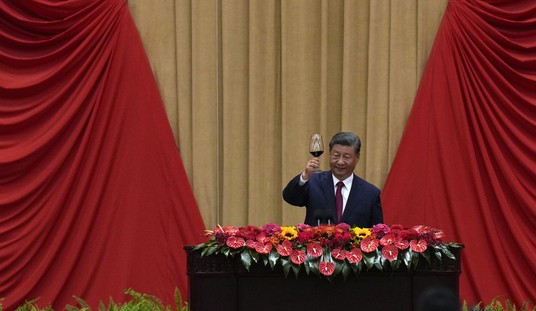In a measure of just how worried Beijing has become over its new coronavirus outbreak, China has expanded its new lockdown policy to two more major cities around its epicenter of Wuhan. Huanggang has over seven million people and Ezhou has more than a million, but both cities will also have their transportation systems shut down and their populations effectively quarantined in order to stop the spread the virus. Not only will residents be unable to leave, they won’t have many places to in public within them either:
On Thursday, authorities in Huanggang—a city of 7.5 million people—said they won’t let long-distance trains and buses run from the urban center and will shut its public transportation system in the lockdown zone, effective midnight Friday local time. Ezhou, another neighboring city with just over a million residents, said it would enact similar restrictions.
Huanggang is about 35 miles east of Wuhan, a city of 11 million and a major hub for travel, where the new pneumonia-causing coronavirus originated. Wuhan just hours earlier halted outbound trains and flights and shut down its public-transportation system.
The Huanggang local government also said movie theaters, internet cafes and other entertainment and cultural facilities in the city center would temporarily halt operations and a central market would be shut down for an indefinite period.
That’s certainly a dramatic move, but will it work? The World Health Organization’s representative in China isn’t so sure:
“To my knowledge, trying to contain a city of 11 million people is new to science. It has not been tried before as a public health measure, so we cannot at this stage say it will or will not work,” Gauden Galea, the World Health Organization’s country representative for China, said in an interview Thursday with the Associated Press, referring to the Wuhan lockdown.
Mr. Galea added that while such a radical measure “obviously has social and economic impacts that are considerable,” it also “demonstrates a very strong public health commitment and a willingness to take dramatic action.”
It also rather dramatically shows the power Beijing has over life in every corner of China. This may or may not be the right move, but it seems pretty clear that the cities themselves aren’t making this call.
This has the potential to backfire too, at least with the internal lockdowns. These lockdowns, especially within the cities, will create more than “social and economic impacts.” People don’t necessarily stock food in these areas the way Americans tend to do, and if they can’t get out to get food and basic necessities, China might have more than one public-health crisis in Wuhan and Huanggang on their hands. Also, if the lockout includes the transport of food and basics into the cities, that creates the same problems even if the markets remain open.
That’s not the only way in which this could backfire. The resentment over this new policy might awaken dissent, which the efforts to build a Xi Jinping cult were designed to contain, the Washington Post reports:
Analysts said the heavy-handed reaction underscored the political risks for Chinese leader Xi Jinping and the ruling Communist Party, already under pressure amid an economic slowdown and accused of mishandling an outbreak of swine flu last year, which led to a sharp spike in prices for China’s beloved pork.
“This outbreak may be the biggest threat to Xi and the Party in years, which is why they will stop at nothing to try to control and then eradicate it,” said Bill Bishop, publisher of the influential Sinocism newsletter.
The central Chinese city of Wuhan pulsated with fear and anger Thursday, as 11 million people awoke to news that they were being confined to a metropolis-sized quarantine zone designed to contain a widening coronavirus outbreak. …
In Wuhan, a city with about 3 million more people than New York, many residents were incensed at the sudden announcement of the travel restrictions on Thursday.
“I didn’t even receive a notice,” said one woman who found herself stranded at Hankou Station. She had been on her way from Henan province southwest to Sichuan and was changing trains in Wuhan when she got caught up in the suspension.
This unprecedented action will generate unprecedented side effects that might overwhelm the original crisis. That will be especially true if these quarantine efforts don’t do anything to stop the expansion of the disease.
CNN reports on the Wuhan lockdown but spends more time looking at the disease itself. Thus far only one confirmed case in the US, but 16 people have been put under observation after having been identified as coming into contact with that person. Sanjay Gupta reviews the process of the disease, and also explains that the NIH is already working on a vaccine. That will take quite a bit of time, and the potential for mutation is high enough to wonder whether epidemiologists can keep up with it enough to get one specific vaccine to stop this particular coronavirus.
At least 17 people are dead in China and more than 600 confirmed infected as coronavirus continues to spread throughout Asia and the world. Wuhan, the city of 11 million people where the outbreak began, is under partial lockdown. @drsanjaygupta reportshttps://t.co/I56QCAViJ9 pic.twitter.com/qy9Az2mzSh
— New Day (@NewDay) January 23, 2020
For the US, the best offense is a good defense. Now that the alert has gone out, inspections and controls at transportation centers will be the main focus, although we won’t shut them down entirely. We got a few lessons from SARS and even Ebola; now it’s time to see how well we learned them.








